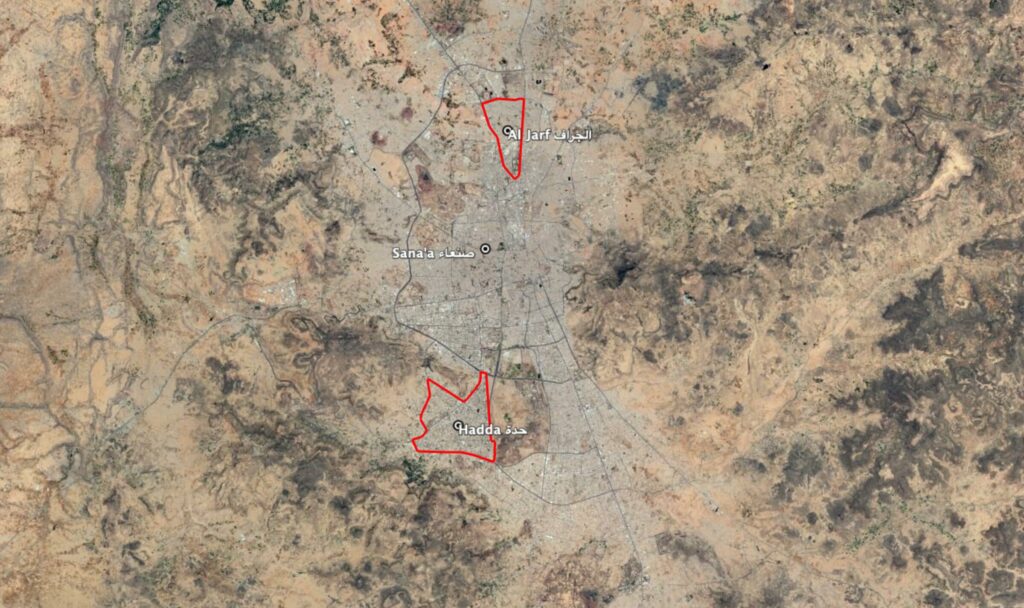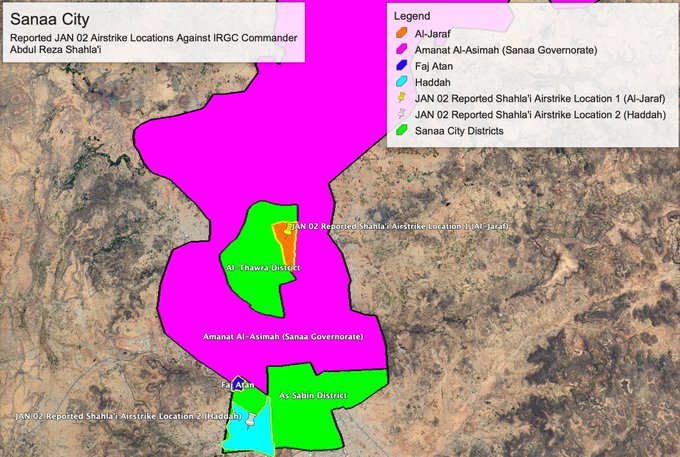Incident Code
Incident Date
Location
Geolocation
Geolocation
Airwars Assessment
(Previous Incident Code: YEMT210)
A US drone strike reportedly targeted Abdul Reza Shahlai, an Iranian Revolutionary Guard and Qods Force commander in Sana’a, overnight from January 2nd-3rd 2020.
While initial reports suggested that Shahlai had been killed in the strike, official sources later indicated that he had survived. There was some indication that another Iranian soldier was killed, however. The strike reportedly took place alongside a second confirmed US drone strike in Iraq, which assassinated Iranian commander Qasem Suleimani early on January 3rd. There were no known associated reports of civilian harm in the strike.
The specific circumstances of the strike were unclear. Though reports initially emerged late on January 3rd, with some suggesting that the attack took place around that time, later reporting by outlets including the Washington Post, ABC, and CNN instead indicated that it took place on the same night as the strike that killed General Suleimani. This chimes with an Erem News report that local sources in Sana’a had denied that there were any airstrikes overnight from January 3rd-4th.
Local language outlets also reported that the strike took place some time overnight from January 2nd-3rd. According to Tahdeeth, the attack took place in the Al Jarf area of Sana’a on January 2nd. Yemen Time further indicated, according to local sources, that the strike took place at 4am “on the day of the killing of Qassem Soleimani”, January 3rd, in the Hadda area of Sana’a city, near the Faj Atan area. According to analyst Joshua Koontz (@JoshuaKoontz__), Hadda lies around 4.5 miles from Al Jarf.
Though initial reports, from Twitter users including @muard_doden and @raed_alamassi, suggested that the strike targeted a car, Yemen Times reported that the target was a house. US officials likewise told ABC News that the strike targeted Shahlai in his “compound”. While most indicated that the attack took the form of a drone strike, a few sources, such as @wesleysmorgan, suggested that the action was a US Special Forces operation.
Four US officials told the Washington Post that Shahlai had survived the attack. “If we had killed him, we’d be bragging about it that same night”, a senior US official told the Washington Post. The Intercept later reported that Shahlai went into hiding after the strike, according to a US counter-terrorism official.
It was further reported by The Intercept that a “lower-level Quds Force operative” was killed in the strike. Sources variously indicated that the killed operative was Iranian Revolutionary Guard leader Mustafa Muhammad Mirzai. On January 6th 2020, Aden Gad reported that, according to Iranian media, Mirzai, was killed in vague “clashes” in Yemen. Iranian state media also reported that Mirzai had died on January 3rd in “one of the fields of the Resistance Front”, at the same time acknowledging a military fatality in Yemen for the first time, according to journalist Amir Toumaj.
Analyst Joshua Koontz also indicated that, according to the IRGC-linked Fars News Agency, Mirzai’s body was flown back to Iran for a funeral in Shahr-e-Ray, Tehran, on January 6th 2020. Quoting Fars, Joshua Koontz indicated that Mirzai was a “comms expert” who had also travelled to Iraq and Syria.
The alleged target of the strike, Abdul Reza Shahlai, supervised the Quds Force division aiding Houthi forces in the Yemeni civil war, The Intercept reported. In December 2019, the US State Department declared a $15 million reward for information on Shahlai. He has been linked to a January 2007 attack on the Karbala Joint Provincial Coordination Centre in Iraq, in which five US soldiers were kidnapped and later killed. In 2011, the US had listed him as a Specially Designated Global Terrorist, for allegedly planning to assassinate the Saudi ambassador to the US. The US Special Representative for Iran, Brian Hook, also said in 2019 that the US was “gravely concerned by his presence in Yemen and potential role in providing advanced weaponry of the kind we have interdicted to the Houthis”.
The Pentagon was coy about the attack. “We have seen the report of a January 2 airstrike in Yemen, which is long-understood as a safe space for terrorists and other adversaries to the United States. The Department of Defense does not discuss alleged operations in the region.” said Pentagon spokeswoman Cmdr. Rebecca Rebarich in a statement to the press.
Subsequently, CENTCOM informed Airwars that it had conducted no strikes in Yemen during January 2020. Officials told the Washington Post, however, that “officials at the Pentagon and at military commands in Florida were monitoring both strikes”, suggesting that the US military had conducted the strike. The DoD also announced, at the time, that they had conducted the strike against Suleimani in Iraq. It is therefore likely that this action was an undeclared US military operation.
Several news outlets reported that the attempted killing of Shahlai undercut the rationale given by US officials for the parallel strike on Qasem Suleimani in Iraq. In the aftermath of the Suleimani strike, The Intercept reported, the US had submitted a letter to the United Nations Security Council, stating that the strike exercised its “inherent right to self-defence”. US officials and President Trump also justified the strike on the basis of an imminent threat posed by Suleimani.
The reported strike in Yemen, however, suggested “a mission with a longer planning horizon and a larger objective, and it really does call into question why there was an attempt to explain this publicly on the basis of an imminent threat”, Suzanne Maloney, an Iran scholar at the Brookings Institution, told the Washington Post. A US official indicated to The Intercept that a strike against Shahlai had been discussed in the Trump administration for three years, “as a means of deterring further Iranian support for the Houthis in Yemen”.
Further, this strike against a Houthi ally was reported to be a significant deviation from prior US policy in Yemen, which had previously emphasised “counter-terrorism” efforts against AQAP and, more recently, ISIS. The attempted killing of Shahlai in Yemen – coupled with the assassination of Suleimani in Iraq at the same time – may point to a preplanned decapitation attempt by the US against the senior leadership of Iran’s military.
Though CENTCOM did not confirm the strike, several major news outlets including ABC News and the Washington Post printed comments from US officials who confirmed details of the attack
Key Information
Geolocation Notes
Reports of the incident mention separate locations within the Sana’a City (امانة العاصمه) district. According to one source, @JoshuaKoontz__, these are the Al Jarf (الجراف) area, for which the generic coordinates are: 15.399569, 44.209156, and the Hadda (حدة) area, south of Sana’a, at these generic coordinates: 15.303724, 44.190960. Due to limited satellite imagery and information available to Airwars, we were unable to verify the location further.

Reports of the incident mention separate locations located within the Sana’a City (امانة العاصمه) district. According to one source, @JoshuaKoontz__, these are the Al Jarf (الجراف) area, and the Hadda (حدة) area, south of Sana’a
Imagery: Google Earth

@JoshuaKoontz__ alleges that two seperate areas have been identified as locations of the strike, these are the Al Jarf (الجراف) area, and the Hadda (حدة) area, south of Sana’a.
Imagery: @JoshuaKoontz__
